What the heck is that?
Our gardeners come from a variety of cultures and nationalities, and we grow a variety of plants, flowers and veggies. Here are some of the common and uncommon items you may see in the garden.
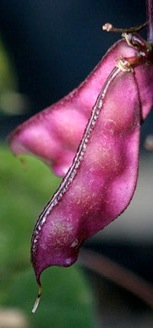
Hyacinth Bean
Lablab Bean 豆子
4 varieties. Growing beautiful flowers and thin pods for vegetable use.
The hyacinth bean grows as a vine, producing purple flowers and striking electric-purple colored seed pods. Lablab bean is a good choice for a quick screen on a trellis or fence. It grows fast, has beautiful, fragrant flowers that attract butterflies and hummingbirds, and it even produces edible leaves, flowers, pods, seeds and roots. Dry seeds are poisonous due to high concentrations of cyanogenic glucosides, and can only be eaten after prolonged boiling.
In the Telangana region of India, bean pods are cut into small pieces and cooked as spicy curry in Pongal festival season, along with bajra bread; it has been a very special delicacy for centuries.
In Huế, Vietnam, it is the main ingredient of the dish chè đậu ván.
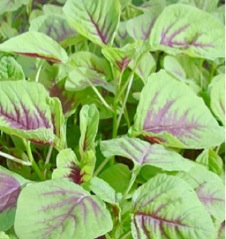
Yin Tsai, Chinese Spinach 可食用的紫紅色
8 varieties: Green Leaf, Red Leaf, White Leaf and Tender Leaf. (red leave shown)
Edible Amaranth grows very well in warm climates. This fast-growing vegetable can be harvested 30 days after sowing, by the cut-and-grow-again method. Seeds are very small and will germinate best at temperature above 65 F under dark conditions. Thin plants during the growth if necessary and thinnings can be eaten. Edible young leaves and stems are cooked like spinach. The amaranth family has many groups of plants found in various regions in the world. The following varieties are the most popular leafy amaranths grown in Asia. Soft texture and tender leaves are excellent for stir-fry and soup.
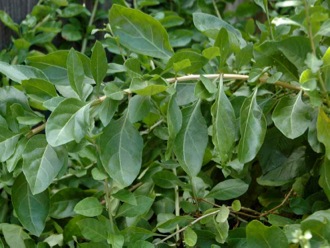 Wolfberry
WolfberryGouqi (Mandarin). gau gei (Cantonese) 枸杞
Pronounced Gow-Gee, the Wolfberry leaves are harvested primarily for use in soups. We've rarely seen the plants go to berry stage here in Berkeley (perhaps a different variety). You'll often find this plant outside of the gardens, in the small beds between a Chinese garden and the path.
"In Chinese herbal medicine, the leaves are said to “clear heat” from the body, and like the berries, they have a strengthening effect on the Liver, Kidneys and Lungs. In Chinese culture, the leaves are typically used in cooking, especially for making soups. They can be used like one would use spinach, including stir-fried and even raw. They have a slightly bitter, pleasant taste. Remove the leaves from the stalk to cook them. The leaves cook very quickly, especially if you are stir-frying them." (courtesy wellpoint.com)

Coriander
Cilantro, Chinese parsley or dhania
4 varieties. A popular herb with spicy aroma.
Coriander is an annual herb in the family Apiaceae. Coriander is native to southern Europe and North Africa to southwestern Asia.
It is a soft, hairless plant growing to 50 centimetres (20 in) tall. The leaves are variable in shape, broadly lobed at the base of the plant, and slender and feathery higher on the flowering stems. The flowers are borne in small umbels, white or very pale pink, asymmetrical, with the petals pointing away from the centre of the umbel longer (5–6 mm) than those pointing towards it (only 1–3 mm long). The fruit is a globular, dry schizocarp 3–5 mm diameter
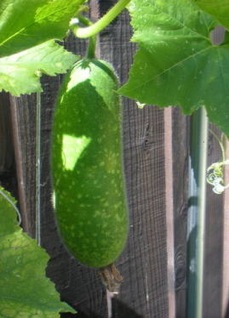
Hairy Gourd/Fuzzy Melon
多毛的葫蘆 Tong Qwa
This unique variety is very popular and widely grown in southern China. Plants produce large size fruits, up to 50 pounds, with dark green skin without wax and white fleash inside.
This subtropic and tropic plant is very vigorous and needs 120-150 days to growing, setting and harvesting fruits, suitable for planting from spring through fall. Oblong shaped fruits, 45-65 cm long and 20-30 cm across, can be stored for a long time, good for a long distance shipping and marketing.
The flesh is firm and mildly flavored. Plants are trained up along supports and should be well watered during hot summer.
NOTE: Hairy Gourd needs insects to carry out the pollinating process for setting fruits.
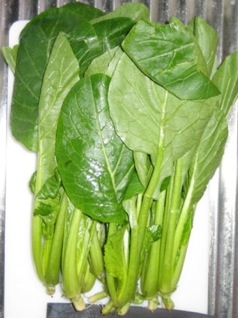
Komatsuna
Japanese Mustard Spinanch 日本芥末菠菜
Komatsuna is a type of leaf vegetable.
It is a variant of the same species as the common turnip. It is grown commercially in Japan, and Taiwan; the name is from Japanese komatsuna
It is also known as Japanese Mustard Spinach and is usually stir-fried, pickled, boiled and added to soups or used fresh in salads. It is an excellent source of calcium.
The leaves of komatsuna may be eaten at any stage of their growth. In a mature plant they are dark green with slender light green stalks, around 30 cm long and 18 cm wide. It is most often grown in the spring and autumn, as it cannot endure extreme heat or cold for more than a short time.
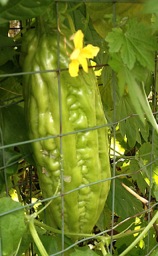
It is a tropical and subtropical vine of the family Cucurbitaceae, widely grown in Asia, Africa, and the Caribbean for its edible fruit, which is among the most bitter of all fruits. Its many varieties differ substantially in the shape and bitterness of the fruit. This is a plant of the tropics.
The fruit has a distinct warty exterior and an oblong shape. It is hollow in cross-section, with a relatively thin layer of flesh surrounding a central seed cavity filled with large, flat seeds and pith. The fruit is most often eaten green, or as it is beginning to turn yellow. At this stage, the fruit's flesh is crunchy and watery in texture, similar to cucumber, chayote or green bell pepper, but bitter. The skin is tender and edible. Seeds and pith appear white in unripe fruits; they are not intensely bitter and can be removed before cooking.
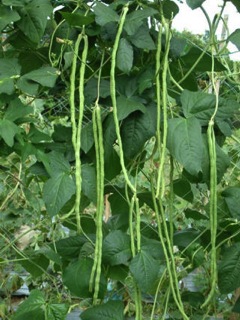 Chinese Long Bean (Zhǎng dòu 长豆)
Chinese Long Bean (Zhǎng dòu 长豆)They look like your standard bean, until they keep growing and growing… They're cooked like a regular bean, to cut up to put into stir fry. A host of recipes can be found on line
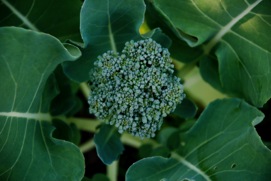
Broccoli is a plant in the cabbage family, whose large flower head is used as a vegetable. The word broccoli, from the Italian plural of broccolo, refers to "the flowering top of a cabbage".[3] Broccoli is usually boiled or steamed, but may be eaten raw and has become popular as a raw vegetable in hors d'œuvre trays.
Broccoli is a cool-weather crop that does poorly in hot summer weather. Broccoli grows best when exposed to an average daily temperature between 64 and 73 °F. When the cluster of flowers, also referred to as a "head" of broccoli, appear in the center of the plant, the cluster is green. Garden pruners or shears are used to cut the head about an inch from the tip. Broccoli should be harvested before the flowers on the head bloom bright yellow.
